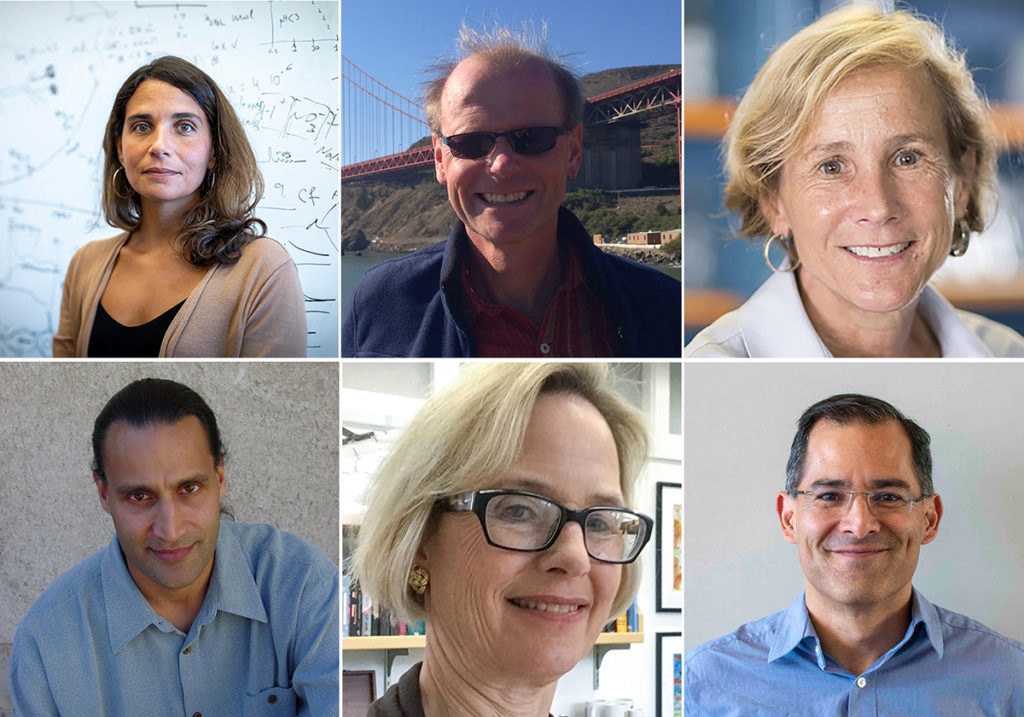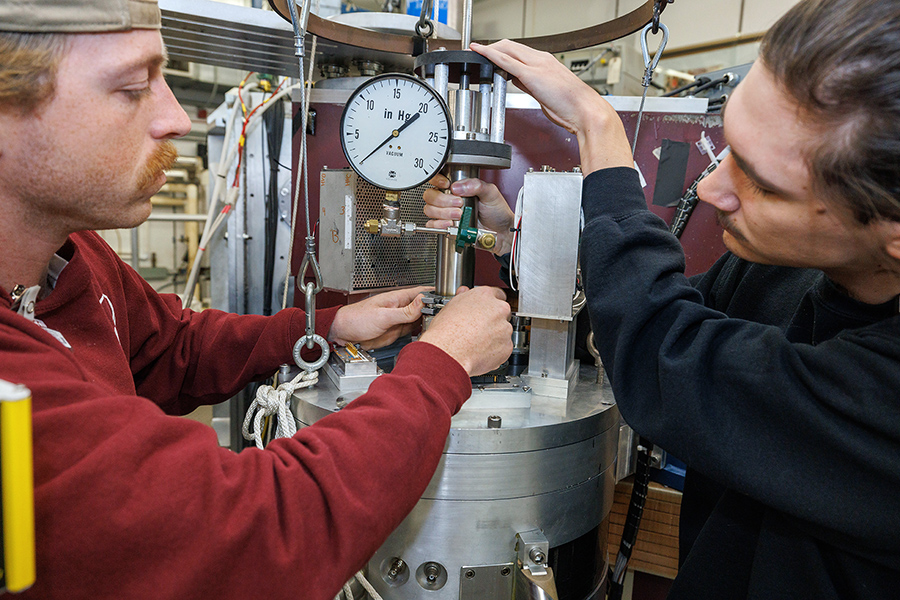AAAS awarded 443 of its members the distinction of Fellow this year for “their scientifically or socially distinguished efforts to advance science or its applications.” The new Fellows from Berkeley Lab are:
- Rebecca Abergel (Chemical Sciences Division)
- Roland Bürgmann (Energy Geosciences Division)
- Cheryl Kerfeld (Environmental Genomics and Systems Biology Division)
- Michael Manga (Energy Geosciences Division)
- Natalie Roe (Physics Division)
- David Schaffer (Molecular Biophysics and Integrated Bioimaging Division)
Rebecca Abergel
Rebecca Abergel, a faculty scientist in Berkeley Lab’s Chemical Sciences Division and assistant professor in UC Berkeley’s Nuclear Engineering Department, was recognized for her “distinguished contributions to heavy element chemistry, particularly applied to the development of new chelation therapies, separation processes, and radionuclide targeted delivery strategies.”
Abergel joined Berkeley Lab in 2009 as a project scientist. Her research career has included the study of heavy element coordination chemistry and biochemistry, and the design and development of advanced therapeutic and diagnostic agents for the mitigation of human contamination from radioactive heavy metals such as plutonium or uranium.
Abergel was the recipient of a Women Chemists Committee Rising Star Award from the American Chemical Society (2017) and an Early Career award from the U.S. Department of Energy (2014). In 2013, she was granted the Berkeley Lab Director’s Award for Exceptional Scientific Achievement. She heads the BioActinide Chemistry Group, the Heavy Element Chemistry Program, and Heavy Element Research Laboratory, and is the director of the Glenn T. Seaborg Center within Berkeley Lab’s Chemical Sciences Division.
Roland Bürgmann
Roland Bürgmann, a faculty scientist in Berkeley Lab’s Energy Geosciences Division and also a professor in UC Berkeley’s Earth and Planetary Science Department, was recognized for “outstanding contributions to research, teaching, innovation, service to societies and to the public in geodynamics, tectonics, rheology, seismology, geodesy and volcanology.”
He heads UC Berkeley’s Active Tectonics Research Group, which focuses on problems relating to fault zone processes and crustal deformation. His recent research projects focus on the active earthquake cycle and post-earthquake deformation in California and along the Denali fault in Alaska and studies of deformation associated with the subduction zone earthquakes in Japan, Chile, and Sumatra.
Cheryl A. Kerfeld
Cheryl A. Kerfeld was recognized for her “distinguished contributions to the field of structure of microbial photosynthetic proteins and compartments, particularly the elucidation of design criteria of bacterial microcompartments.” Kerfeld is the Hannah Distinguished Professor of Structural Bioengineering at the Michigan State University (MSU)-DOE Plant Research Laboratory and Department of Biochemistry and Molecular Biology, as well as guest faculty in Berkeley Lab’s Environmental Genomics and Systems Biology and Molecular Biophysics and Integrated Bioimaging divisions.
Kerfeld’s research combines methods in bioinformatics, cellular imaging, and synthetic and structural biology to understand the fundamental principles of bacterial metabolism.
In addition to her ongoing work on bacterial microcompartments and cyanobacterial photoprotection, Kerfeld’s career has also focused on developing and implementing innovative undergraduate biology curriculum. She first worked to improve the curriculum at UCLA, where she had completed her training as a National Science Foundation Postdoctoral Fellow. Then, in 2007, she established the Genomics and Bioinformatics Education Program at the U.S. Department of Energy Joint Genome Institute. The program, nationally recognized as an exemplary contribution to undergraduate education by the American Society of Biochemistry and Molecular Biology, trains STEM faculty on how bioinformatics tools and resources can be used to help teach students through research projects.
Michael Manga
Michael Manga, a faculty scientist in Berkeley Lab’s Energy Geosciences Division and also chair of UC Berkeley’s Earth and Planetary Science Department, was recognized for “many outstanding contributions to geological processes involving fluids in physical volcanology, geodynamics, hydrogeology, and geomorphology, and for service to academe, government, and societies.”
His current research interests focus on human-induced earthquakes, the behavior of geysers, water on Mars, and volcano science. His work aims to develop a better quantitative understanding of physical processes operating in the Earth.
Natalie Roe
Natalie Roe, director of Berkeley Lab’s Physics Division since 2012, was recognized for her work in “developing instrumentation that opens new frontiers in experimental particle physics and observational cosmology, and for continuing to build bridges between the fields.
Roe, a senior scientist, joined Berkeley Lab in 1989 as a postdoctoral fellow. Her particle physics research career has included the analysis of subatomic particle properties in accelerator-based experiments at SLAC and Fermi National Accelerator laboratories, and her cosmology research has involved surveys using telescopes based in Arizona, New Mexico, and Chile.
She has participated in several instrument R&D projects, leading the design and construction of a silicon vertex tracker for the BaBar experiment at SLAC and overseeing the fabrication of red-sensitive charge-coupled device detectors for the Dark Energy Survey as group leader for Berkeley Lab’s Microsystems Laboratory. She also led the upgrade of the Sloan Digital Sky Survey spectrographs as instrument scientist for the Baryon Oscillation Spectroscopic Survey. She has served on numerous scientific and advisory panels and was named a fellow of the American Physical Society in 2001.
David V. Schaffer
David V. Schaffer was recognized for his “pioneering contributions to biomolecular engineering, with particular attention to directed evolution to create viruses for the efficient, targeted, and safe delivery of gene medicines.” Schaffer is a professor in three UC Berkeley departments – Chemical and Biomolecular Engineering, Bioengineering, and Neuroscience – and at the Helen Wills Neuroscience Institute. He also serves as the director of the Berkeley Stem Cell Center and is a chemist faculty scientist in Berkeley Lab’s Molecular Biophysics and Integrated Bioimaging Division.
Schaffer’s research group uses molecular and cellular engineering approaches to design medical gene therapy and stem cell platforms, with a focus on therapeutics targeting neuroregeneration. This work also includes mechanistic studies of stem cell control processes and the evolution of viral gene delivery vehicles.
In addition to his academic positions, he has co-founded four therapeutics companies. The largest company, 4D Molecular Therapeutics, is currently developing viral vector-based treatments for Fabry disease, cystic fibrosis, Duchenne muscular dystrophy, and several degenerative eye diseases.
Additional information
The new AAAS Fellows will be presented with an official certificate and a gold and blue rosette pin on Saturday, Feb. 15 at the AAAS Fellows Forum during the 2020 AAAS Annual Meeting in Seattle, Washington.
For additional information about AAAS, see www.aaas.org.
###
Founded in 1931 on the belief that the biggest scientific challenges are best addressed by teams, Lawrence Berkeley National Laboratory and its scientists have been recognized with 13 Nobel Prizes. Today, Berkeley Lab researchers develop sustainable energy and environmental solutions, create useful new materials, advance the frontiers of computing, and probe the mysteries of life, matter, and the universe. Scientists from around the world rely on the Lab’s facilities for their own discovery science. Berkeley Lab is a multiprogram national laboratory, managed by the University of California for the U.S. Department of Energy’s Office of Science.
DOE’s Office of Science is the single largest supporter of basic research in the physical sciences in the United States, and is working to address some of the most pressing challenges of our time. For more information, please visit energy.gov/science.
Original post https://alertarticles.info



